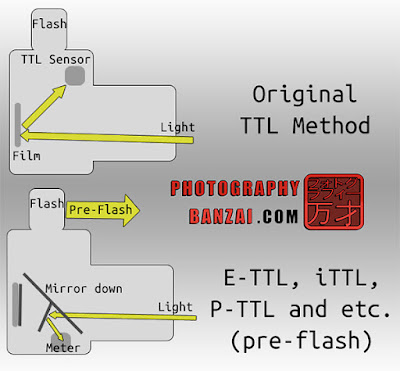I talk about camera flash communication methods (TTL vs E-TTL i-TTL p-TTL) as well as thyristor sensor based auto mode.
 |
| Flash talk |
Diagram for TTL and pre-flash based TTL methods:
 |
| TTL and more advanced methods. |
Standard TTL:
This was the original method of flash power control. It happens as the film/sensor is being exposed to light. There is a dedicated sensor near the film that monitors the reflected light off of the film/sensor and eventually tells the flash to “quench” (stop) outputting light. The nice thing about TTL is that it works with any lens and was generally pretty reliable.
p-TTL, E-TTL, i-TTL, and similar systems that use pre-flash:
This is the newer method that all of the camera manufacturers use now. The flash sends out a pre-flash burst of light (or multiple bursts) and records the results with the standard light meter built into the camera. So this all happens even before the mirror has been flipped up and of course before the sensor
Thyristor auto flash:
Some flash units have a built-in light meter called a Thyristor. This allows the flash to control the output itself to achieve a decent exposure. Some flash units pull the aperture value from the camera and other units have manual input fields to take the aperture and ISO from the user. This works quite well in most situations, but keep in mind that large light modifiers should not cover or block the sensor.